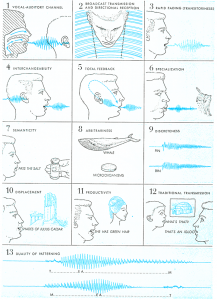Dolphins talk to each other, recorded first time in history!
This article was originally posted at Amazing Zoology
For the first time in history, scientists have recorded a full-fledged conversation between two bottlenose dolphins. It was known for years that dolphins use very complex language to communicate each other. But it is the first time we get clear evidence to say they are stringing together words to create sentences and even have grammar, a recent study[1] says.
What was the experiment?
Signals produced by dolphins are classified into five different types. Of these, ‘mutually noncoherent pulses’ or ‘NPs’ were considered for the current study. The experiments were performed on two adult Black Sea bottlenose dolphins (Tursіps truncatus), named Yasha (male) and Yana (female), in a closed concrete pool. The speech patterns were recorded using waterproof Hydrophones places in the pool. The recordings of these dolphins were saved and analysed using various techniques.
[caption id="attachment_883" align="alignnone" width="600"]
 Anatomy of sound production and detection in dolphin[/caption]
Anatomy of sound production and detection in dolphin[/caption]What does the observations say?
Analysis of the recordings clearly shows that dolphins took turns in producing the pulse packs. And they never interrupted each other. This shows that each of the dolphins listened to each other before producing its own pulse pack.
The pulses were produced in packs. They produced pulses that varied in frequency, volume and spectrum. So these pulses can be considered as words and pulse packs as sentences. Human language is very similar to this, we produce various words using variation in frequency, volume etc. and combine these words to produce sentences. There are even evidences of grammatical structures, but much research is needed to confirm this.
Features of a language
Dolphin conversation can be analysed for considering as a language using the features described by Hockett.[2] The thirteen features of a spoken language according to Hockett are:
- Vocal-auditory channel
[caption id="attachment_886" align="alignright" width="217"] Attributes of a spoken language by Hackett[/caption]
Attributes of a spoken language by Hackett[/caption] - Broadcast transmission and directional reception
- Rapid fading
- Interchangeability
- Total feedback
- Specialization
- Semanticity
- Arbitrariness
- Discreteness
- Displacement
- Productivity
- Traditional transition
- Duality of patterning
All these thirteen attributes are exhibited by the conversation recorded between dolphins. This shows a high level of intelligence and consciousness in dolphins. Also their language can be considered a highly developed spoken language, similar to human language. The only thing is, we are just beginning to understand it. This claim is supported by the fact that dolphins have possessed brains that are somewhat larger and more complex than human ones for more than 25 million years.
Along with this…
[caption id="attachment_884" align="alignnone" width="1024"]
 They really have emotions, like humans![/caption]
They really have emotions, like humans![/caption]Researchers in 2011[3] have found that dolphins value friendship and relatives just like us. Another study published in 2016[4] shows that dolphins and whales mourn for the dead. The existence of a similar highly developed spoken language in toothed whales (Odontoceti) is also suggested based on the similarity of their acoustic signals and morphology.
[cite]
References
1.
Ryabov V.A. (2016). – The study of acoustic signals and the supposed spoken language of the dolphins. St. Petersburg Polytechnical University Journal: Physics and Mathematics, 2 (3), 231–239. doi: 10.1016/j.spjpm.2016.08.004
2.
Hockett C.D. (1960). – The origin of speech. Scientific American, 203 (3), 99–196.
3.
Dolphins value good friends and relatives (2016). UNSW Science for society. Available at: https://www.science.unsw.edu.au/news/feature-dolphins-value-good-friends-and-relatives (accessed on 7 October 2016).
4.
Reggente M.A.L., Alves F., Nicolau C., Freitas L., Cagnazzi D., Baird R.W. & Galli P. (2016). – Nurturant behavior toward dead conspecifics in free-ranging mammals: new records for odontocetes and a general review. Journal of Mammalogy, 97 (5), 1428–1434. doi: 10.1093/jmammal/gyw089
Comments
Post a Comment